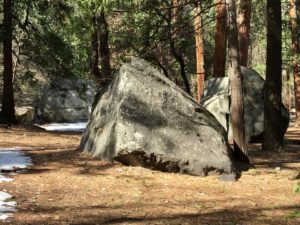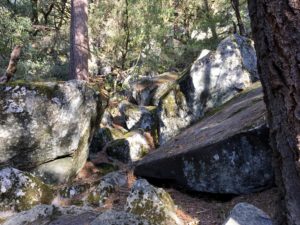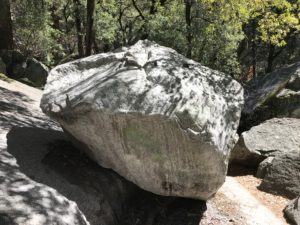Leaving Yosemite is not an easy thing to do. I told my kids that I felt like it was a privilege to be there, and for me, a place that you could never get too much of. But I also left feeling worn down both physically and emotionally. The loss of my phone, the corresponding expense of that, and the mostly rain and cold of the final five days there, left me spent. Although I still think it was the right decision, abandoning my plan for time in the Tahoe area didn’t help either. But as I came down out of the mountains, with cold rain still falling and a soggy camper, I retraced my route back to Ridgecrest, CA, and could feel my body relaxing in the warm afternoon of later that day.
It was always my intention to give a nod to the importance of Yosemite to the climbing community so I will end with that.
Recently a man named Royal Robbins passed away. He was a well known figure in Yosemite and led the team of three that first summited the face of Half Dome in 1957. That ascent took five days. Today, it’s a checklist climb that the current crop of phenoms do for a day. Ten years after the Robbin’s team, Royal’s wife Liz became the first women to summit the face. In 1958 the first ascent of “the nose” of El Capitan was done by Warren Harding with a team of three others. That climb took eleven days and was “watched” by climbers from around the world. Today you almost can’t believe the records that have been posted and fallen over the years on Yosemite’s iconic climbs.
In the years after World War II climbing was largely a European sport practiced by wealthy adventurers who could afford it. The rise of climbing in the US had a different path. All around Yosemite are massive boulders and “bouldering” almost became a sport unto itself. It made Yosemite not only a place of challenging climbs but a place where people could come and learn. They put “crash pads” around the boulders so mistakes could be made with little or no consequence. Established climbers from around the world became their teachers and Yosemite became the climbing Mecca of the US. An informal climbing school eventually became a formal climbing school that still operates in Half Dome Village. If you follow this history, there were any number of famous clashes between the Park Rangers and a growing vagabond community of climbers, who would ignore the fourteen day camping limit and flock to the park to set up camp for the climbing season. Even if climbing is not a specific interest, this marriage of sport and obstacle, as it played out in Yosemite, is a “great read”. (read that, web search) 🙂
This seems like a good place to end the Yosemite chapter. Climbing and climbers have always been a fascination for me and I’ve watched and read a lot of material about them. Watching some of the things they do on film sometimes electrifies my whole body. The strength and nerve that it takes is not something within me, so my fascination has always been from a distance. I wanted to write something about that piece of the park’s lore.


